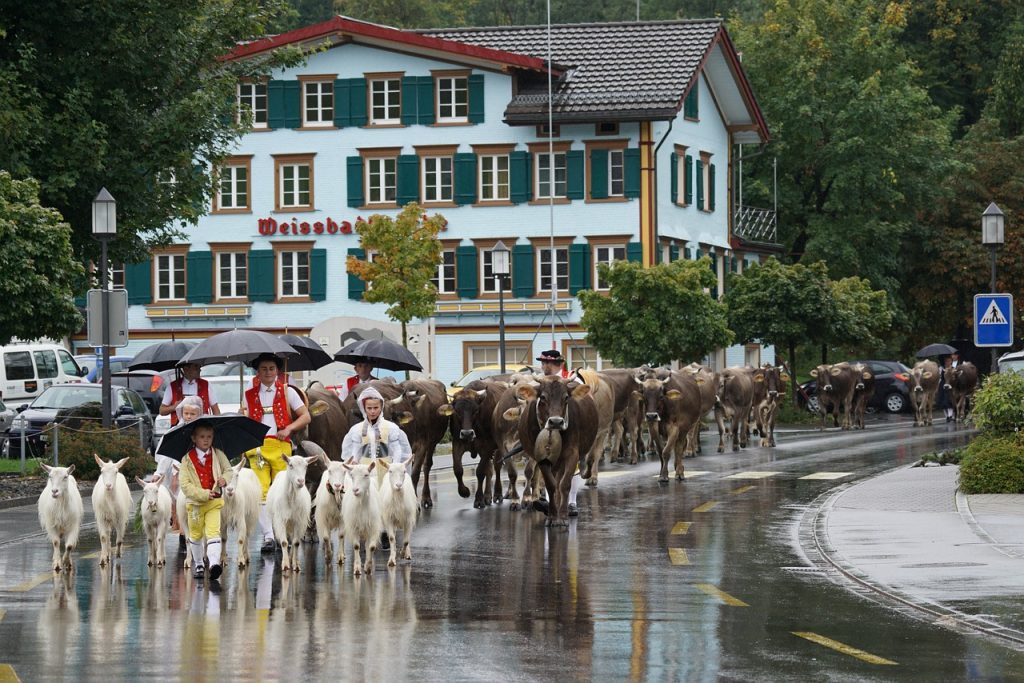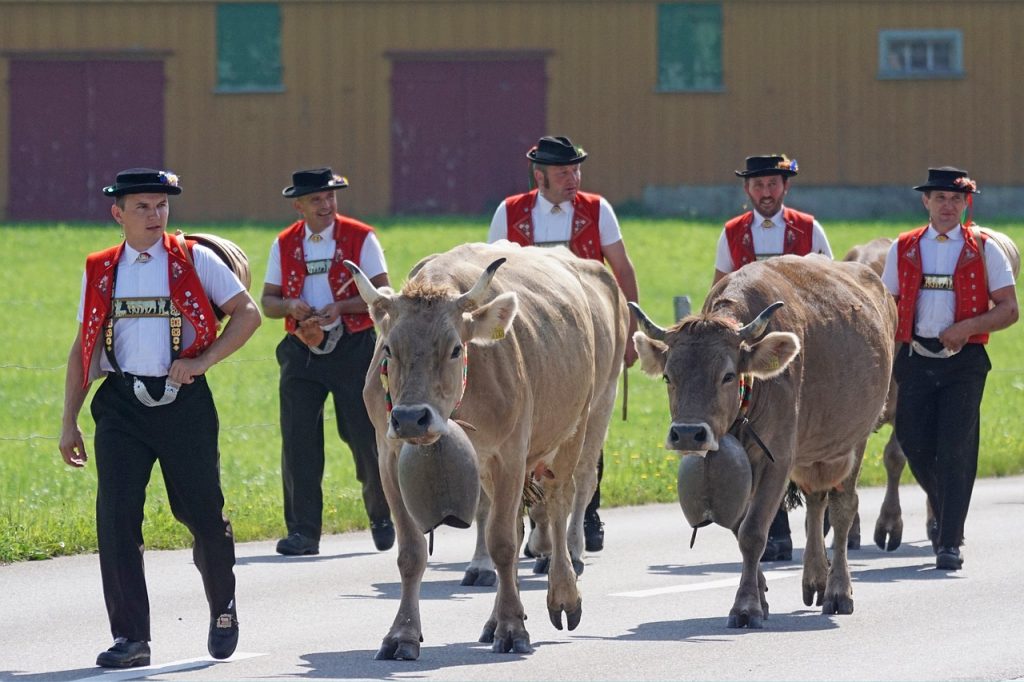السبت, أكتوبر 30th 2021

The Alpine descents mark the end of summer, bringing the cows down from the mountains before the weather turns too cold.
The tradition of returning livestock from higher altitudes is referred to as Alpabzug in Swiss-German, or désalpe in French. These parades take place mainly during the month of September, although some might be as late as the beginning of October.
Before the first snow of the season, the cows, cattle, goats, and pigs that were grazing on alpine meadows during summer will descend to the farms in the valleys. There, they will be spending the winter months in a barn, munching on hay and feed.
On paper, having cows descend from a mountain does not seem all too exciting. But this annual Swiss tradition comes with a lot of fanfare. As long as none of the livestock has been lost that summer, farmers will decorate their grass-fed beauty queens for the parade.
Each region in Switzerland (and in the entire alpine region, for that matter) has its own intricate traditions. But generally speaking, a flower “crown” between a cow’s horns is not uncommon, and a large bell is almost standard wherever you go.

After all, milk cows are nothing less than the pillars of Swiss traditional food. For everyone involved, an alpine livestock parade is a day-long festival rather than a mere logistical operation.
As bringing home the livestock is a family tradition, you will usually find up to three generations in a single procession.
Given that the Swiss love structured things, this tradition is no exception. Depending on the number of livestock involved as well as the region, a parade might be a rather casual affair. You might spot farmers and their family members wearing jeans and hiking boots, meanwhile herding their livestock along a paved street.

On the other hand, in a place such as Alpstein in Eastern Switzerland, alpine livestock descents have a predefined setup. Take Appenzell or Weissbad where you would find a goat herder boy leading a group of white goats. The youngest participant of a parade is then followed by farmer girls in charge of driving the goats.

In this region, it is common for a dairyman to be leading the rest of the parade. Three dairy cows, the belles of the ball, will get the prime spot. They can be identified by the largest bells on their necks and the most ornate decorations. The remaining cows, cattle, and even pigs will follow.
Cows are really important in Swiss culture. Not only do they provide grass-fed milk but they are also at the heart of a lot of Swiss traditional foods such as cheese or dry meat. In fact, if you are interested in how Swiss farming methods contribute to organic living, take a look at this article about alpine hay harvest. It is a century-old tradition taking place in several alpine regions in Switzerland.
As for the alpine descents, they are common in all parts of Switzerland except for Ticino in the south. Wanting to witness this spectacle is also a great excuse to visit parts of the country you have not seen before.
For starters, there are the must-see parades in Engelberg, Gstaad, or Urnäsch. But we would also recommend giving a visit to smaller villages that are just as important to the fabric making up Swiss culture. While you are standing along the street, you might as well strike up a chat with the locals. What better way to pick up some words in Swiss-German, French, or maybe even Romansh?
These alpine parades not only consist of the actual movement of livestock. They are a welcome occasion for neighbors to gather. Equally, these events are an opportunity to get in touch with local life. Especially in small villages, onlookers will get to experience how welcoming and generous the Swiss truly are.
A small piece of advice: if someone offers you a glass of wine, offer up the next round. This way you will communicate that you are enjoying this shared moment as much as they do. In Switzerland, great friendships flourish around great food and a shared drink (or two). And in order to impress a Swiss, learn something about the wine regions in Switzerland.
Many of the larger livestock parades from the alpine meadows to the valleys are combined with a farmers’ market. Usually located in the destinations of the parades, these markets are a treasure trove for foodies. Among the various booths, discover traditional and organic food of the particular region. Is there a better taste than that of tradition, passion, and love?
While strolling the markets, take a moment to talk with the vendors. Many of whom are likely going to be locals who have been farming for multiple generations. You will quickly see how proud they are of their artisanal and organic products, often produced for decades in the same household. When you take a bite of the summer’s cheese from the Alps, you will surely be able to taste the difference: this food is real and organic.
Fun fact: the taste of the cheese is influenced by the types of grass and herbs a cow is consuming.
As autumn is at our doorsteps, we would highly recommend you to take part in this Swiss tradition. You can find all the 2021 Alpabzug parades and their regions in this overview on Newly Swissed.
While you are experiencing an alpine festival, why not take part in a healthy life? If cows can hike for hours, so can you: pick any one of these cable cars for peak hunters.
